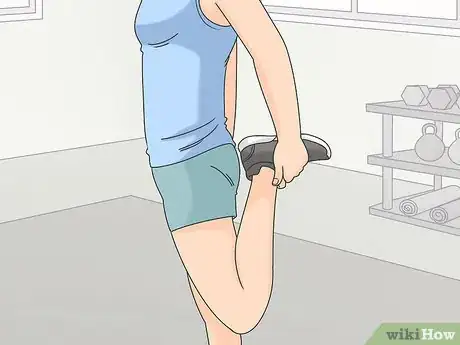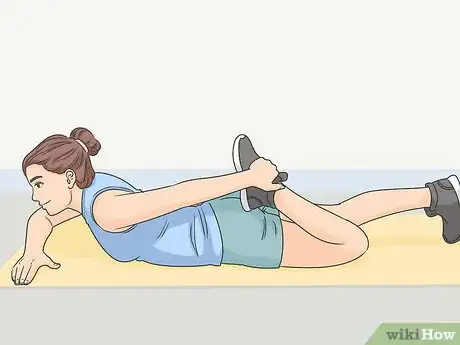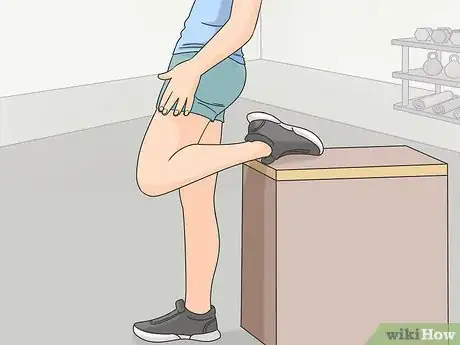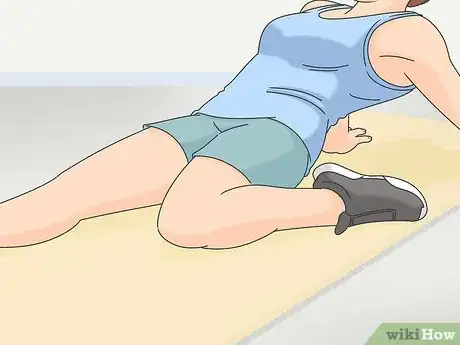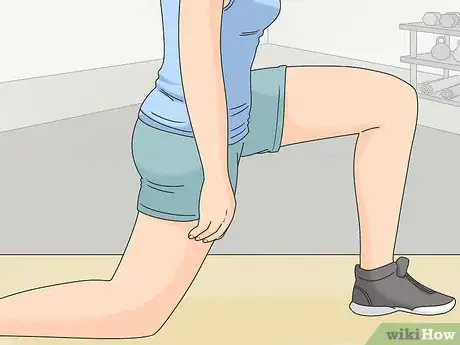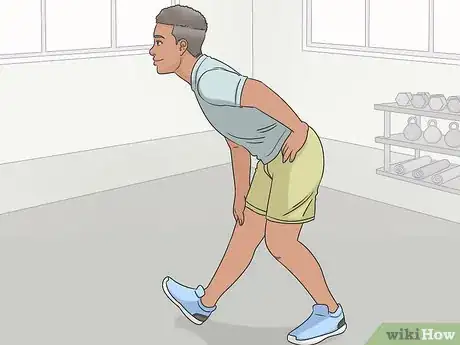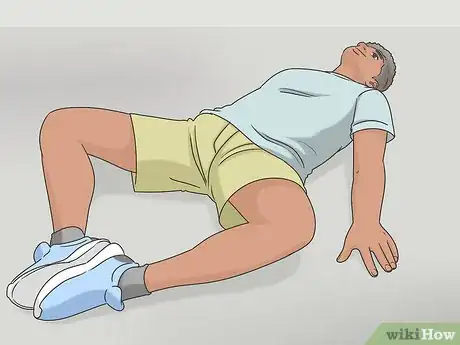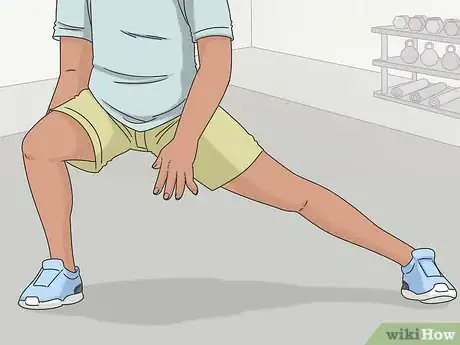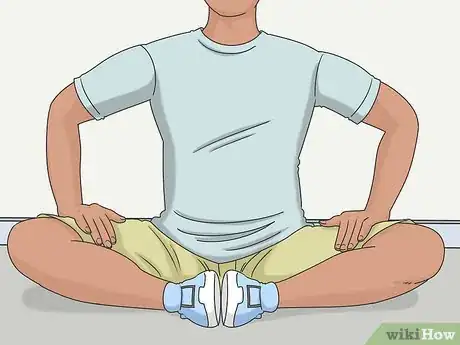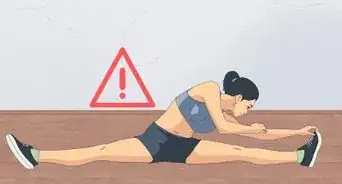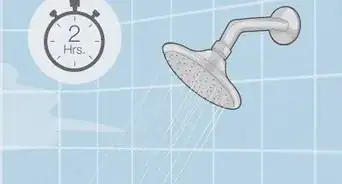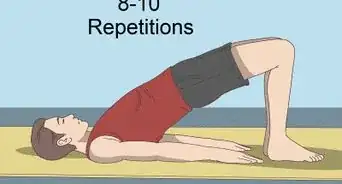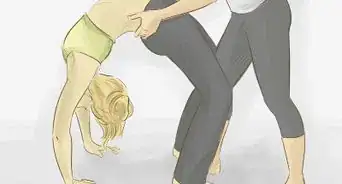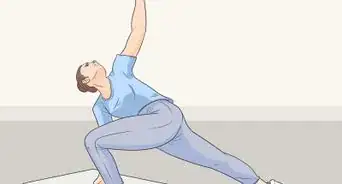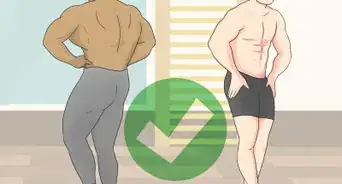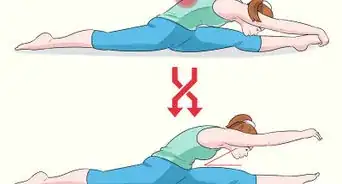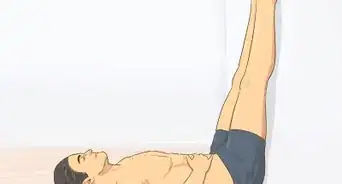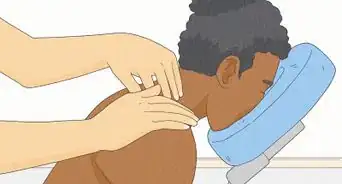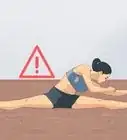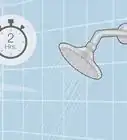This article was co-authored by Eric Martinez. Eric Martinez is a Registered Clinical Exercise Physiologist and the Vice President of Infinity Sports Institute in Miami, Florida. With over a decade of experience, Eric specializes in clinical exercise physiology, human optimization, and sports science. He works with professional and Olympic athletes as well as high-risk patients. Eric holds an MS in Exercise Physiology from Barry University and is a Registered Clinical Exercise Physiologists in the State of Florida. Eric holds 15 different certifications in specialties such as strength and conditioning, injury prevention, neuro biomechanics, and Kinesio taping. He trains hundreds of coaches in Nero and Clinical Physiology certifications.
There are 9 references cited in this article, which can be found at the bottom of the page.
This article has been viewed 178,270 times.
It’s important to stretch out your quadriceps—the muscles located on the fronts of your thighs—before you engage in any form of exercise that uses your legs. Also stretch the muscles of your inner thighs—the adductor muscles—to prevent muscle pulls in your groin. Stretching your thigh muscles increases the amount of blood that’s flowing into them and loosens up the muscle tissue, preventing strains or tears. Also be sure to stretch your thigh muscles if you received a leg injury and are supposed to stretch as part of a physical-therapy routine.
Steps
Stretching Your Upper Thighs
-
1Pull 1 foot at a time up towards your rear to stretch your quads. Bend your left knee so that your foot is behind you and grab your left foot in your left hand. To stretch out your quadriceps, pull up on your foot. You’ll feel the muscles on the front side of your left thigh stretch and loosen up. Keep your knee pointed straight down towards the floor. Hold this pose for 10–15 seconds, and release your leg if you feel any pain in your thigh muscles.[1]
- Once you’ve stretched out your left quadriceps, switch legs and hold your right foot in your right hand. As with the left leg, pull up on the foot to stretch your quads.
- While you’re holding the stretch, push your hips forwards to stretch the muscles even farther.
-
2Lie on your stomach and pull up 1 leg you at a time up behind. Recline on your stomach on top of a yoga mat or carpeted floor. Bend your left knee and reach back with your left hand. Grasp your foot in your hand and pull up on it until your heel is resting on your rear. Keep your hips pressed downward into the floor. Hold the stretch for 10–15 seconds, and release by gradually lowering your leg back down to the floor.[2]
- Once you’ve stretched out your left leg, repeat the stretch with your right leg.
Advertisement -
3Stretch 1 thigh at a time by bending your knee and placing a foot on a bench. Find a knee-height bench or, if you’re at the gym, a knee-high jump box. Bend your left knee and rest the top of your foot left on the bench. Lean your torso backwards and press your hips forward to stretch out your quadriceps. Hold the stretch for 5 seconds, and repeat it 4–5 times. Then, repeat the stretch on the opposite side by placing your right foot on top of the box.[3]
- Stop stretching if you feel any pain. While the sensation of your quadriceps stretching may be slightly uncomfortable, you shouldn’t feel a tearing or burning sensation.
-
4Bend 1 knee at a time while in a seated position on the floor. If you don’t have access to a jump box or bench, you can stretch out your quadriceps in a similar way from a seated position. Sit down, extend 1 leg out in front of you, and bend your other leg at the knee. When it’s fully bent, your heel should be resting on the ground next to your buttocks. To stretch your quadriceps, lean your torso back until you’re at a 45-degree angle relative to the ground. Hold the pose for 5 seconds, and repeat it 4–5 times. Then, switch legs and repeat the stretch with your right quad.[4]
- If your knees start to ache during this stretch, use one of the other options to stretch out your quadriceps. This stretch can be potentially painful for people with injured or weak knees.
-
5Kneel on a yoga mat and lunge forward with 1 leg at a time. This stretch is a great way to focus on stretching your quads separately. Kneel with your right knee and place your left foot out in front of your body. Your knee should be bent at a 90-degree angle. To stretch your right quad, slide your hips and the trunk of your body forward until you feel your right quad stretching. Hold the stretch for just 1–2 seconds. Repeat the kneeling lunge 10 times before switching your position.[5]
- When you switch, kneel with your left leg and place your right leg in front of you. Lean forward until you feel your left quad stretch.
Stretching Your Inner Thighs
-
1Reach down and touch your toes with your fingertips. This simple stretch is a great way to loosen up the muscles on the backs and inside of your thighs. Let the weight of your upper body pull your hands and fingertips lower towards your feet. It’s okay if your fingertips don’t touch your toes at first. Never force your body to bend more than is comfortable; doing so could tear a muscle.
- Stop stretching if you feel any pain. You should feel the muscles at the tops of your thighs stretch, but the sensation shouldn’t be painful.
-
2Stretch your hamstrings by aligning your feet and leaning to the side. Stand with your hands on your hips. Place your right foot 2–3 inches (5.1–7.6 cm) in front of your left foot. Keep your right leg straight and slightly bend your left leg. Lean to the right until you feel a slight burn in the back of your right thigh. Switch your stance so that your left leg is in front of your right, and lean to the left until you feel your left hamstring stretch.[6]
- If you have trouble keeping your balance during this stretch, rest 1 hand against a nearby wall.
- Your hamstrings are long muscles that run down the back of your inner thigh. They go from the back of your knee up to your hips.
-
3Press your feet together and open your knees to stretch the adductors. Do this stretch when you’re lying flat on your back. Press the soles of your feet together, and bend your knees to draw your feet up towards your groin. Keep bending your knees until you feel your quadriceps stretching. To further stretch your inner thighs, just use your hands to press your knees out and downward (towards the surface you’re lying on). Hold the pose for 15–20 seconds.[7]
- Repeat this stretch 4–5 times to really loosen up your inner thighs. If you’re not feeling much of a stretch, try lightly pushing down on your knees to stretch your adductors a little farther.
- You can adjust the amount that your inner thighs stretch by bringing your knees closer to or farther from your torso.
-
4Do side lunges to warm up your inner thighs from a standing position. Stand with your knees slightly bent and with your feet shoulder-width apart. Bend your left knee and step 2–3 feet (0.61–0.91 m) to the left with your left foot. Keep your right leg straight; you should feel the muscles on the inside of the leg stretch.[8] After a 10-second stretch, push up with your left leg, bend your right leg, and transfer the stretch to your other side. Hold this for 10 seconds as well.[9]
- Side lunges are a great way to warm up before a run (or jog) when you aren’t able to stretch from a prone position.
-
5Lie with your rear against a wall and your legs vertical against the wall. Sit on the ground next to a wall in your home or gym. Stick your legs up in the air, and scoot your body around until your rear is pressed against the wall. Rest your heels and the backs of both legs against the wall. To stretch out your adductor muscles, separate your legs and slide them down towards the ground. To make the stretch more difficult, bring your legs farther apart and your feet closer to the ground.[10]
- Keep your knees locked throughout this stretch. If you find this stretch uncomfortable, try placing a blanket or a thin pillow behind you on the wall.
-
6Try a butterfly pose by sitting with your feet pressed together. This is a more challenging inner-thigh stretch. Sit on the ground (ideally on a yoga mat) with your knees bent. Press the soles of your feet together and wrap your hands around the outsides of your feet. Exhale and, as you do so, bring your heels in towards your groin. To stretch the muscles of your inner thighs, gently pull your knees down towards the floor. Don’t force them, and stop if you feel pain. Hold the position as long as you comfortably can for anywhere between 1–10 minutes.[11]
- Not only does this stretch out the muscles of your upper thighs area, it also stretches your lower back and opens up your hips.
- This yoga pose is also commonly referred to as Bound Angel pose or Baddha Konasana.
Expert Q&A
-
QuestionWhy does my back hurt when I stretch my thigh?
 Eric MartinezEric Martinez is a Registered Clinical Exercise Physiologist and the Vice President of Infinity Sports Institute in Miami, Florida. With over a decade of experience, Eric specializes in clinical exercise physiology, human optimization, and sports science. He works with professional and Olympic athletes as well as high-risk patients. Eric holds an MS in Exercise Physiology from Barry University and is a Registered Clinical Exercise Physiologists in the State of Florida. Eric holds 15 different certifications in specialties such as strength and conditioning, injury prevention, neuro biomechanics, and Kinesio taping. He trains hundreds of coaches in Nero and Clinical Physiology certifications.
Eric MartinezEric Martinez is a Registered Clinical Exercise Physiologist and the Vice President of Infinity Sports Institute in Miami, Florida. With over a decade of experience, Eric specializes in clinical exercise physiology, human optimization, and sports science. He works with professional and Olympic athletes as well as high-risk patients. Eric holds an MS in Exercise Physiology from Barry University and is a Registered Clinical Exercise Physiologists in the State of Florida. Eric holds 15 different certifications in specialties such as strength and conditioning, injury prevention, neuro biomechanics, and Kinesio taping. He trains hundreds of coaches in Nero and Clinical Physiology certifications.
Clinical Performance Specialist & Registered Clinical Exercise Physiologist Clinical Performance Specialist & Registered Clinical Exercise PhysiologistExpert AnswerYou're probably irritating your qL. That runs from the thigh to the upper back, so stretching the thigh often irritates this, especially if you're doing something like a hip flexor or kicking stretch.
Clinical Performance Specialist & Registered Clinical Exercise PhysiologistExpert AnswerYou're probably irritating your qL. That runs from the thigh to the upper back, so stretching the thigh often irritates this, especially if you're doing something like a hip flexor or kicking stretch. -
QuestionWhat's the easiest and most effective stretch for a tight thigh?
 Eric MartinezEric Martinez is a Registered Clinical Exercise Physiologist and the Vice President of Infinity Sports Institute in Miami, Florida. With over a decade of experience, Eric specializes in clinical exercise physiology, human optimization, and sports science. He works with professional and Olympic athletes as well as high-risk patients. Eric holds an MS in Exercise Physiology from Barry University and is a Registered Clinical Exercise Physiologists in the State of Florida. Eric holds 15 different certifications in specialties such as strength and conditioning, injury prevention, neuro biomechanics, and Kinesio taping. He trains hundreds of coaches in Nero and Clinical Physiology certifications.
Eric MartinezEric Martinez is a Registered Clinical Exercise Physiologist and the Vice President of Infinity Sports Institute in Miami, Florida. With over a decade of experience, Eric specializes in clinical exercise physiology, human optimization, and sports science. He works with professional and Olympic athletes as well as high-risk patients. Eric holds an MS in Exercise Physiology from Barry University and is a Registered Clinical Exercise Physiologists in the State of Florida. Eric holds 15 different certifications in specialties such as strength and conditioning, injury prevention, neuro biomechanics, and Kinesio taping. He trains hundreds of coaches in Nero and Clinical Physiology certifications.
Clinical Performance Specialist & Registered Clinical Exercise Physiologist Clinical Performance Specialist & Registered Clinical Exercise PhysiologistExpert AnswerI'm fond of the mini forward lunge, where you step forward, stretch the hip out, and then reach the same hand out to the leg behind you. That's a fairly easy stretch that will get your flexors and thighs well-stretched.
Clinical Performance Specialist & Registered Clinical Exercise PhysiologistExpert AnswerI'm fond of the mini forward lunge, where you step forward, stretch the hip out, and then reach the same hand out to the leg behind you. That's a fairly easy stretch that will get your flexors and thighs well-stretched.
References
- ↑ https://youtu.be/YjxNxljYdaI?t=26
- ↑ https://youtu.be/YjxNxljYdaI?t=79
- ↑ Eric Martinez. Clinical Performance Specialist & Registered Clinical Exercise Physiologist. Expert Interview. 18 May 2021.
- ↑ https://youtu.be/nYpsVuDEJbo?t=32
- ↑ https://youtu.be/iayBtEr06vQ?t=24
- ↑ https://www.nhs.uk/live-well/exercise/how-to-stretch-after-a-run/
- ↑ https://www.doyouyoga.com/5-yoga-poses-to-help-you-get-into-straddle-splits/
- ↑ Eric Martinez. Clinical Performance Specialist & Registered Clinical Exercise Physiologist. Expert Interview. 18 May 2021.
- ↑ https://www.nhsinform.scot/illnesses-and-conditions/muscle-bone-and-joints/exercises/exercises-for-thigh-problems#standing-quad-stretch
